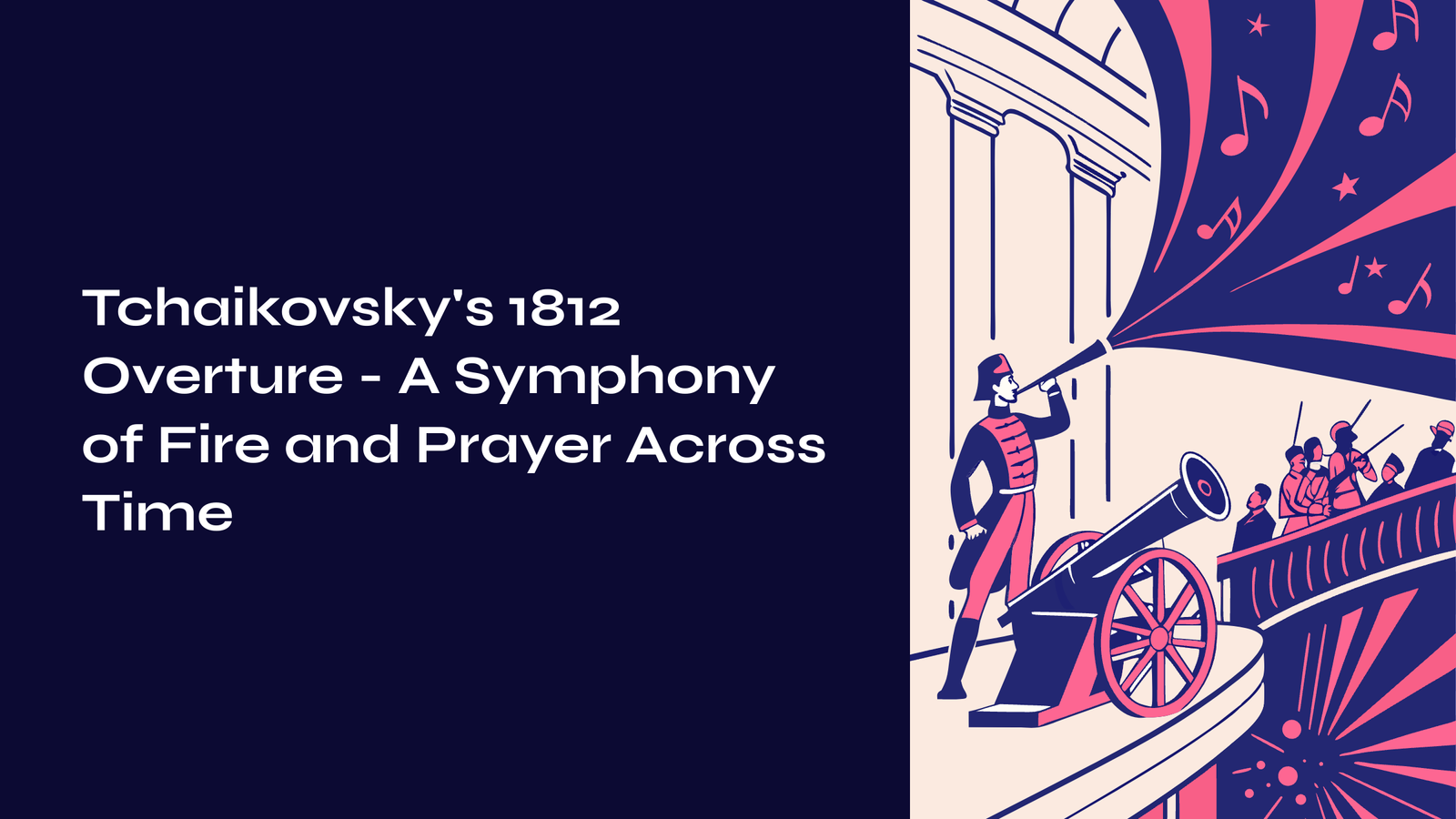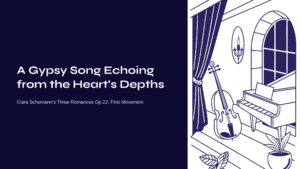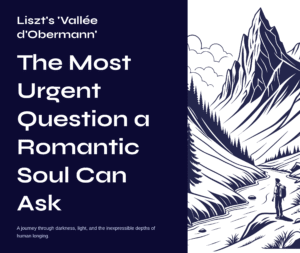Table of Contents
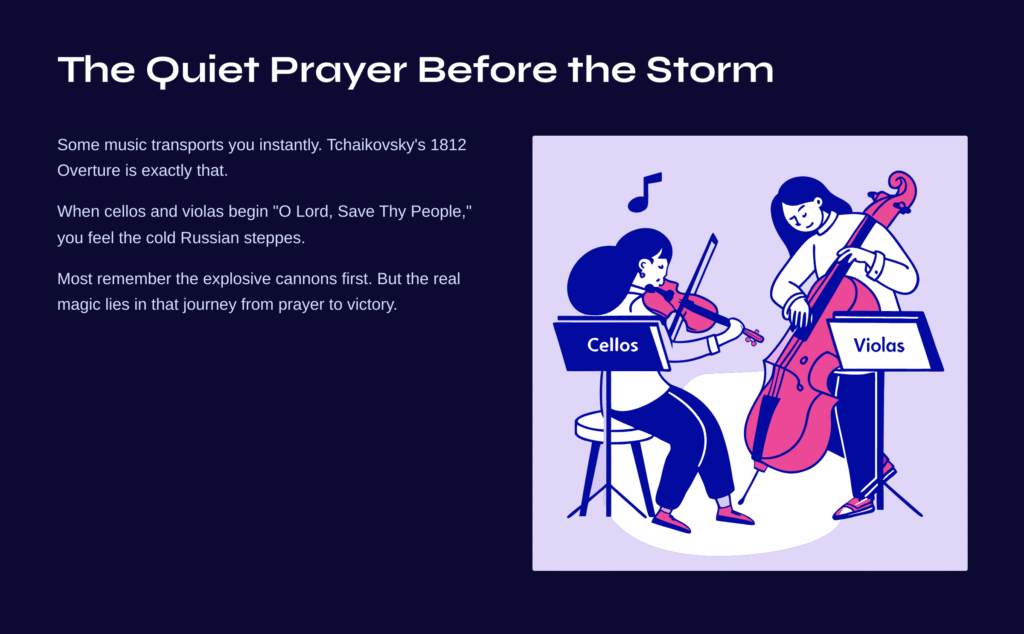
The Quiet Prayer Before the Storm
Some music transports you to another time and place from the very first note. Tchaikovsky’s 1812 Overture is exactly such a work. When the cellos and violas quietly begin the Russian Orthodox hymn “O Lord, Save Thy People,” you can almost feel the cold wind blowing across the Russian steppes of 1812.
Think back to when you first encountered this music. Most likely, you remember the explosive cannon fire and triumphant finale first. But the real magic lies in its beginning—that incredible journey from desperate prayer to majestic victory.
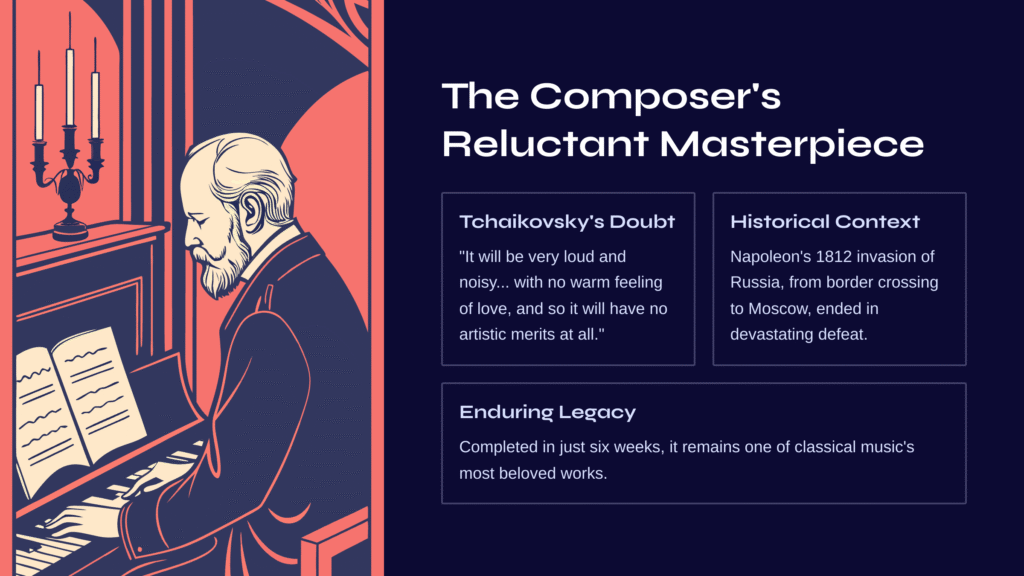
The Composer’s Reluctant Masterpiece
Tchaikovsky wasn’t particularly fond of this work. When commissioned in 1880 to write festival music for the completion of Moscow’s Cathedral of Christ the Saviour, he confided: “It will be very loud and noisy, but I wrote it with no warm feeling of love, and so it will have no artistic merits at all.”
Yet history laughs at the composer’s modest assessment. The 1812 Overture has become one of the most beloved and frequently performed works in classical music history. It’s deeply ironic that this piece, completed in just six weeks, continues to stir hearts more than 140 years later.
The year 1812 marked a decisive moment in Russian history. Napoleon’s Grande Armée crossed the Russian border and advanced all the way to Moscow, only to meet devastating defeat at the hands of the brutal winter and Russian resistance. Tchaikovsky compressed this dramatic history into a mere 15 minutes of orchestral music.

A Musical Epic of War
Despair and the Beginning Prayer
The overture opens quietly with a Russian Orthodox hymn. When the strings play this trembling melody like flickering cathedral candles, we imagine Russian people kneeling in prayer before their invaders. This moment of silence makes the coming storm all the more dramatic.
Collision of Two Worlds
Soon the woodwinds introduce the Russian folk song “At the Gate,” painting a picture of peaceful daily life. But this pastoral mood doesn’t last long. We hear the distant approach of military marches, drumbeats growing closer… and finally, the entrance of “La Marseillaise.”
When the French national anthem thunders through the full orchestra, we instinctively know that Napoleon’s army is trampling Russian soil. Here, Tchaikovsky’s orchestration reaches its peak. The French and Russian melodies oppose each other, intertwine, and compete in what feels like watching an actual battle unfold.
The Climax of Battle and Winter’s Revenge
As the music reaches its climax, every instrument plays with full force. Timpani crash like thunder, brass instruments cry out the horrors of war. But here Tchaikovsky’s true genius emerges—even amid the brutality of battle, he never forgets human suffering.
In the following section, strings and woodwinds depict the harsh Russian winter. Spiraling downward melodies evoke images of French soldiers freezing to death in the Siberian wilderness.
Victory and the Bells of Salvation
Finally, the Russian Imperial anthem “God Save the Tsar” rings out majestically. The church bells and sixteen cannon shots that follow are not mere sound effects. They represent God’s answer to faith that never wavered even in despair, and heaven’s fanfare announcing that justice has triumphed.
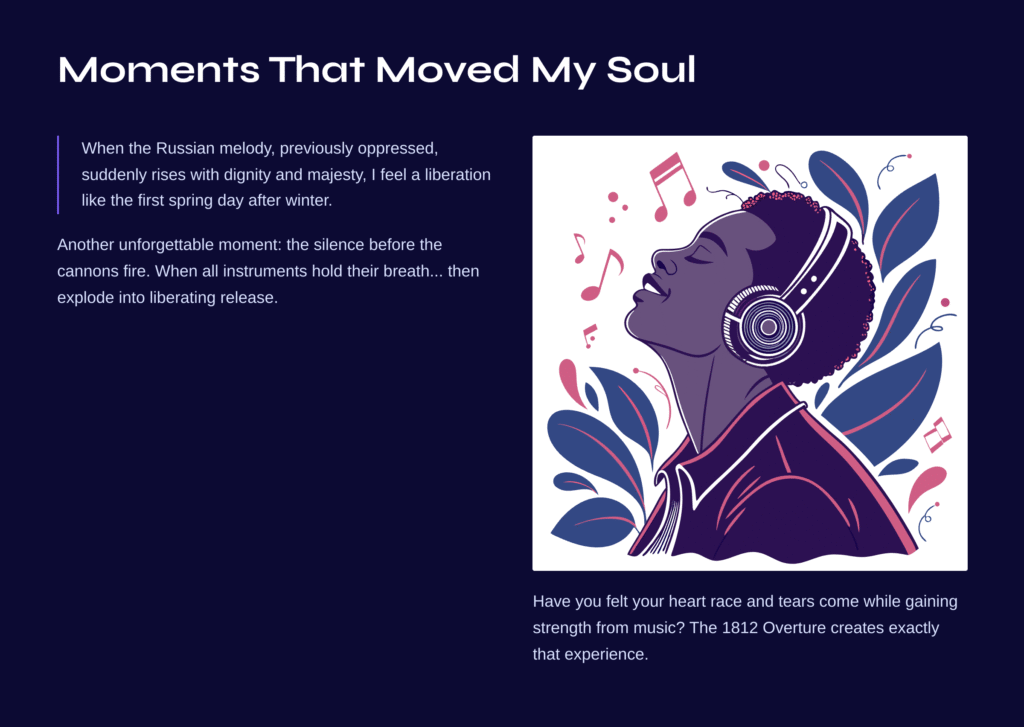
Moments That Moved My Soul
Every time I hear this piece, I get chills at the same point: the moment when the Russian Imperial anthem first appears. When the Russian melody, previously oppressed and trampled, suddenly rises with dignity and majesty, I feel a liberation like the first spring day after a long winter.
Another unforgettable moment is the silence just before the cannons fire. When all instruments hold their breath and the world seems to stop… then explodes into liberating release. This isn’t mere sound effect—it’s the eruption of suppressed emotion, the triumph of justice after long waiting.
Have you ever experienced something similar? Listening to music and suddenly feeling your heart race, tears come, and simultaneously gaining some great strength? The 1812 Overture is exactly that kind of music.
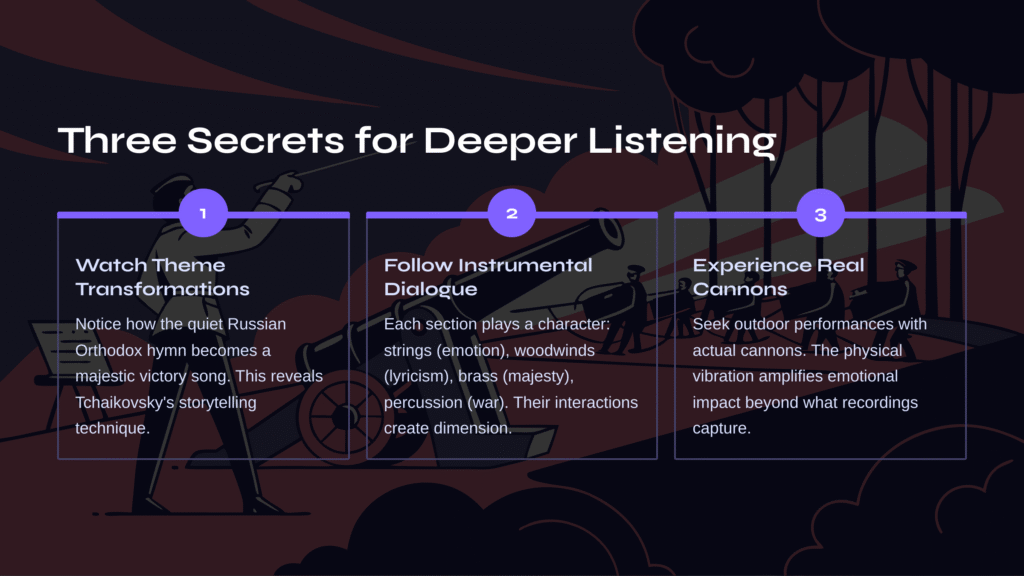
Three Secrets for Deeper Listening
First: Watch the Transformation of Themes
The true brilliance of the 1812 Overture lies in how the same melody transforms completely depending on the situation. Don’t miss the process by which the Russian Orthodox hymn, which begins quietly, becomes a majestic victory song at the end. This is the essence of Tchaikovsky’s storytelling technique.
Second: Listen to the Instruments’ Dialogue
In this piece, each instrumental section plays a different character. Strings represent emotion, woodwinds convey lyricism, brass instruments embody majesty, and percussion symbolizes war. Following how they dialogue, compete, and harmonize with each other will make the music sound much more three-dimensional.
Third: Seek Out Performances with Real Cannons
If possible, I strongly recommend experiencing an outdoor performance that uses actual cannons. The physical vibration and explosive energy that recordings can never capture amplifies the music’s emotional impact many times over. You can find such opportunities at American Fourth of July concerts or some outdoor concerts in other countries.

The Power of Music Across Time
Why does this work that Tchaikovsky dismissed as having “no artistic value” continue to be loved today? Perhaps it’s because of the fundamental story this music contains—humanity’s eternal journey from despair to hope, from defeat to victory, from suffering to liberation.
When we listen to the 1812 Overture, we’re not simply hearing about the war between Russia and France. We’re hearing the drama of trials and triumph that every human faces in life. That’s why this music, born in 19th-century Russia, still resonates powerfully with those of us living in the 21st century.
When the music ends and the last cannon shot fades into echo, we finally realize a profound truth: true victory isn’t defeating enemies, but never losing hope even in desperate circumstances. And the overwhelming joy when that hope finally becomes reality.
Tchaikovsky unknowingly left behind a timeless masterpiece. This grand symphonic poem weaving together cannons and bells, prayer and victory, continues to resonate somewhere in the world today, stirring the hearts of new audiences.
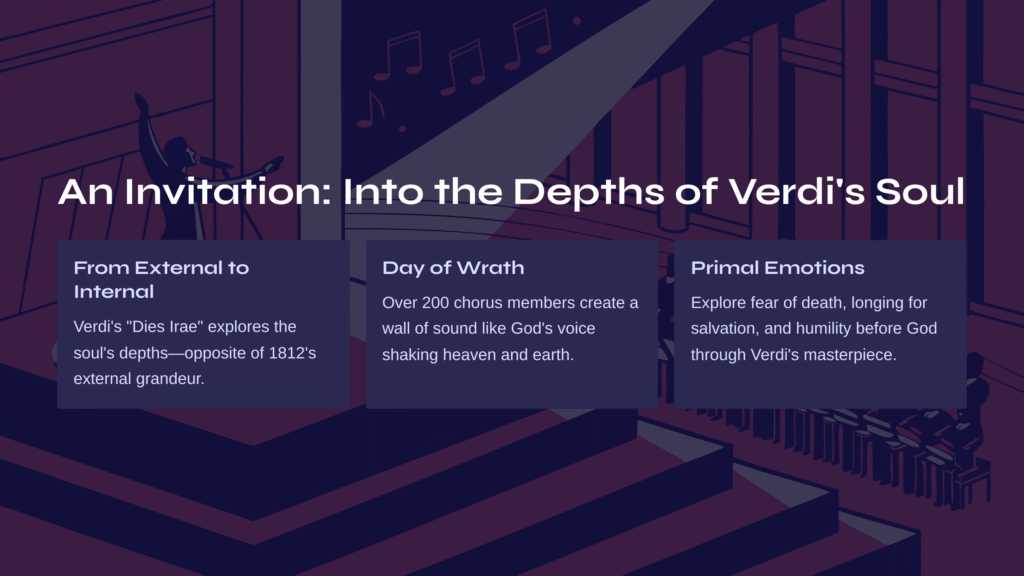
An Invitation to the Next Journey: Into the Depths of Verdi’s Soul
Having experienced the majesty of cannons and bells in Tchaikovsky’s 1812 Overture, it’s time to encounter a completely different dimension of musical transcendence. Verdi’s “Dies Irae” from his Requiem deals with awe and terror emerging from the deepest recesses of the human soul—the exact opposite of the 1812 Overture’s external grandeur.
If the 1812 Overture tells the story of earthly war and victory, Dies Irae depicts the soul’s final judgment unfolding between the netherworld and our world. Where Tchaikovsky celebrated victory with cannons, Verdi poses fundamental questions about human existence through chorus and orchestra.
Dies Irae, meaning “Day of Wrath,” expresses human fear and awe of Judgment Day through overwhelming sound, based on melodies derived from medieval Latin chant. The wall of sound created by over 200 chorus members and a massive orchestra feels like the voice of God shaking heaven and earth.
Through Verdi’s masterpiece, let’s explore together how music can express humanity’s most primal emotions—fear of death, longing for salvation, humility before God. Departing from the 1812 Overture’s triumphant cheers, this will be a journey into the deep ocean of silence and meditation.
